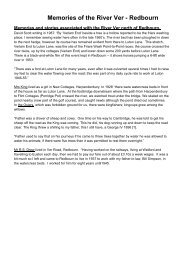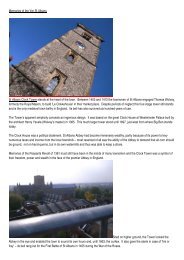RIVER VER TRAIL - Ver Valley Society
RIVER VER TRAIL - Ver Valley Society
RIVER VER TRAIL - Ver Valley Society
You also want an ePaper? Increase the reach of your titles
YUMPU automatically turns print PDFs into web optimized ePapers that Google loves.
The River <strong>Ver</strong><br />
The River <strong>Ver</strong> has been flowing through its valley in Hertfordshire for hundreds of thousands of years since the last<br />
Ice Age. The <strong>Ver</strong> <strong>Valley</strong> <strong>Society</strong> (VVS) and Countryside Management Services have devised a series of eight<br />
circular <strong>Ver</strong> <strong>Valley</strong> Walks and a linear River <strong>Ver</strong> Trail to enable the public to<br />
appreciate this fascinating landscape.<br />
In particular, by interpreting the river in its cultural context, it is possible to<br />
understand how the river has changed over time due to human activities.<br />
The River <strong>Ver</strong> is a chalk stream. Chalk streams are globally rare, only<br />
about 200 in the world, and with their pure alkaline waters they support<br />
a very particular mix of flora and fauna. Most of them occur in the<br />
south and east of England and the River <strong>Ver</strong> is one of them. It runs for<br />
17 miles from its sometime source at Kensworth Lynch to Bricket Wood<br />
where it joins the Colne passing through several County Wildlife Sites<br />
Millstones at<br />
and some valuable historical sites notably in St Albans and its surroundings.<br />
Redbournbury Mill<br />
It is joined by two small tributaries, the River Red at Redbourn and the<br />
Hanstead Brook just above the Colne confluence.<br />
Over the centuries man has developed the river and made use of its power, constructing a dozen watermills<br />
and associated mill-channels, which have modified the water course over much of the river’s length.<br />
Many of the mill buildings still exist and some wheels still operate.<br />
Commissioned as part of the Discover<br />
the River <strong>Ver</strong> Project, these benches<br />
interpret the local area on the carved<br />
backrests as well as provide a perfect<br />
resting spot to enjoy the view.<br />
Position of a <strong>Ver</strong> <strong>Valley</strong> Bench.<br />
B<br />
The Upper Reaches<br />
The top of the river above Redbourn up to Kensworth is now<br />
considered to be the winterbourne section, only flowing when<br />
it is being fed from the underlying chalk aquifer in times when<br />
groundwater levels are high, usually at the end of wet winters<br />
when significant recharge has occurred. OS maps put the source at<br />
Kensworth Lynch and others consider it to be Markyate Cell but in<br />
recent years it is usually the outfall from Markyate sewage works, in<br />
Redbourn at the end of summer or even in times of severe drought<br />
south St Albans.<br />
Source of the<br />
River <strong>Ver</strong> at Many springs feed into the <strong>Ver</strong> as it moves down the valley. At Friars<br />
Corner Farm Wash, near junction 9 of the M1, several springs and now dry valleys<br />
meet. This has been found to be a nationally important site of<br />
Roman temples and other finds have indicated it as a site of worship since prehistoric times.<br />
Roman remains have been discovered all down the valley but of course <strong>Ver</strong>ulamium itself<br />
(St Albans) is the most significant historical location.<br />
Trail<br />
www.riverver.co.uk<br />
Influences on the Flow<br />
The chalk aquifer of the <strong>Ver</strong> <strong>Valley</strong> was laid down<br />
over millennia as countless billions of small<br />
prehistoric crustaceans died and sank to the floor<br />
of the prehistoric seas. Chalk is porous and absorbs<br />
rainwater from above, which soaks down through<br />
the rock rising periodically as springs which feed the<br />
river. As it has been filtered through the chalk, the<br />
water is very pure, mineral rich and emerges at a<br />
constant temperature. The flow in the River <strong>Ver</strong> is<br />
dependent on rainfall to recharge this aquifer.<br />
Recharge largely happens in the winter and early spring; any rainfall<br />
during the summer has little effect as surface water evaporates and is<br />
used up by growing vegetation. Although after heavy rains, at any time<br />
of year, the run-off can cause short-term improvement in flow,<br />
it takes many weeks for any effect to be measured in<br />
aquifer levels or to have any long-term<br />
effect on the river.<br />
KEY<br />
Follow these<br />
waymarks<br />
on the<br />
River <strong>Ver</strong> Trail<br />
<strong>RI<strong>VER</strong></strong> <strong>VER</strong> <strong>TRAIL</strong><br />
Route<br />
<strong>Ver</strong>ulamium Park Roman Wall<br />
Nowadays much of the groundwater is pumped<br />
up to supply the needs of the district. Veolia<br />
Water Company is licensed by the Environment<br />
Agency to abstract over 30 million litres<br />
of water per day from the <strong>Ver</strong> aquifer<br />
by pumping water up from deep<br />
underground using several<br />
pumping stations the length of<br />
the valley. Friars Wash Pumping<br />
Redbournbury Mill<br />
Station near Flamstead has<br />
been on stand-by status since<br />
1993 (as a result of pressure by the <strong>Ver</strong> <strong>Valley</strong> <strong>Society</strong>).<br />
However, it is still used everyday to extract one million<br />
litres and was used in the drought summer<br />
of 2006.<br />
Following the Buncefield Oil Depot disaster in December 2005, fears<br />
of pollution from the fire-fighting chemicals, meant that Bow Bridge<br />
Pumping Station was not used for nearly three years. It remained out of<br />
use from 2006 to August 2009 in case the water table was contaminated<br />
and this certainly helped maintain the flow in the <strong>Ver</strong> over those<br />
summers. The aquifer was at or above average for much of 2008 and<br />
into 2009 but fell below average later in 2009 and at the start of 2010.<br />
As a general measure of the aquifer situation the <strong>Ver</strong> <strong>Valley</strong> <strong>Society</strong> uses<br />
groundwater figures measured by Environment Agency at Ballingdon<br />
Farm in the upper part of the valley. These figures and the rainfall figures<br />
from Rothamstead Research Station are published regularly on the <strong>Ver</strong><br />
<strong>Valley</strong> <strong>Society</strong> web site (www.riverver.co.uk).




